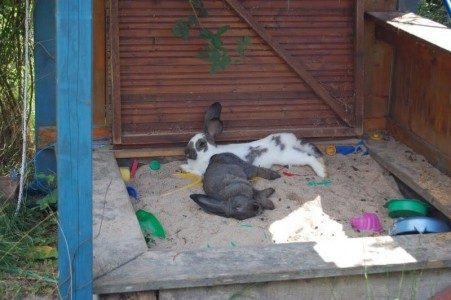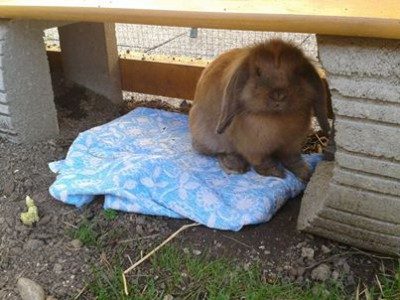What to Do in Case of Heatstroke in Rabbits
„In the summer months, rodents and rabbits often experience fatalities due to heatstroke, as they are unable to sweat because they lack sweat glands and thus cannot release excess body heat. They primarily regulate their internal body temperature through breathing, exhaling heat. Therefore, these animals are very heat-sensitive. Even sustained temperatures in the range of 25-28°C can lead to severe heat stress, especially in poorly ventilated areas, resulting in circulatory collapse.“
Federal Association of Practicing Veterinarians e.V.
How does heatstroke occur?
It is not uncommon to see small outdoor enclosures or cage tops placed on lawns in gardens, exposed to full sunlight without any shaded areas or proper shelters. Similarly, small hutches placed directly in the sun can heat up quickly, trapping the rabbits in what becomes a „oven.“ Transportation in non-air-conditioned cars or living in attic apartments that heat up quickly can also lead to overheating. If the rabbit is fortunate, the owner or a passerby notices that something is wrong. Unfortunately, if the rabbit is unlucky, it may die from circulatory failure due to heatstroke.

How to recognize heatstroke in rabbits?
Possible symptoms of hyperthermia (heatstroke):
- Initially, the rabbits become restless and try to avoid the sun.
- The rabbits may stop moving and lie stretched out on their sides or crouched in a corner, withdrawn.
- Shallow, increased side breathing (side „belly movements“).
- Increased nasal breathing (the nostrils move significantly).
- Sometimes, there is a moist nose or even a wet chin (drooling).
- Red, warm ears.
- Elevated body temperature (around 40°C or higher, but note that stress can also raise the temperature).
- Faster heart rate (which is not detectable to the untrained eye).
- Pale mucous membranes (eyes, mouth).
- The rabbits may lose coordination and have difficulty moving, or even experience paralysis in some cases.
- In some cases, there may be convulsions or signs of shock.
Heatstroke is always an emergency!
Rabbits cannot sweat or pant, making them even more sensitive to heat than humans or dogs. They can only release a small amount of body heat through their ears (warm ears).

First Aid
If you find a rabbit lying lethargically in its enclosure on a hot day, breathing heavily with strong side movements, and overheated, please immediately move it to a cooler area. Submerge the rabbit in cold water (without the head) to cool it down as quickly as possible. The sooner this happens, the higher the chances of survival. Pouring water over the rabbit is also an acceptable alternative.
When transporting the rabbit, place a wet towel underneath it and dampen its ears and fur with wet towels. Immediately contact a veterinarian, as they can stabilize the rabbit’s circulation with IV fluids.
If the rabbit is already unconscious, cool the limbs in cold water and ensure to monitor its breathing and heartbeat closely.
Veterinary Emergency Measures for Heatstroke in Rabbits
- Move the rabbit to a cool place to lower the body temperature.
- Place the rabbit on wet towels or use them for cooling (compresses).
- Use cold water to reduce body temperature and stabilize circulation. Submerge the rabbit or its limbs in cold water, or wet its fur with damp towels.
- Intravenous fluids: Vollelektrolytlösung (Ringer’s lactate, Sterofundin) – 80–100 ml/kg once daily intravenously or 40 ml/kg twice daily subcutaneously. After stabilization, fluid administration may be reduced.
- Oxygen therapy depending on the condition.
- Antibiotics (e.g., Enrofloxacin) to prevent septicemia and stabilize gut flora (since heat can disturb the cecal flora).
- Temperature monitoring to ensure it stabilizes.
- If necessary, hospitalization until stabilization.
- Cactus compositum (ad us. vet.) 0.5 ml/kg, every 3 hours if needed, and Coffea praeparata (ad us. vet. – Plantavet), 0.25 ml/kg subcutaneously, as well as 3 times daily 0.2 ml/kg orally for at least 3 days if necessary.
„Among the most common victims of heatstroke are rabbits, guinea pigs, and pet birds, whose cages or outdoor enclosures are exposed to full sunlight throughout the day. […] The commercially available small wooden shelters are insufficient as sole sources of shade. A widespread misconception is that rabbits and guinea pigs do not need drinking water. This misconception can have fatal consequences for the animals during the hot summer months.“
Federal Association of Practicing Veterinarians e.V. (bpt)
Sources include:
Amici, A., Canganella, F., & Bevilacqua, L. (1998): Effects of high ambient temperature in rabbits: metabolic changes, caecal fermentation and bacterial flora. World Rabbit Science, 6(3-4), 319-324.
Amici, A., Franci, O., Mastroiacono, P., Merendino, N., Nardini, M., & Tomassi, G. (2000): Short term acute heat stress in rabbits: functional, metabolic and immunological effects. World Rabbit Science, 8(1), 11-16.
Ewringmann, A. (2016): Leitsymptome beim Kaninchen. Thieme Verlag
Köstlinger, S. (2014): Notfälle beim Kaninchen. kleintier konkret, 17(S 02), 2-7.
Zinke, J. (2004): Ganzheitliche Behandlung von Kaninchen und Meerschweinchen: Anatomie, Pathologie, Praxiserfahrungen; 14 Tabellen. Georg Thieme Verlag.
Zinke, J. (2005): Behandlung nichtinfektiöser Erkrankungen bei Kaninchen und Meerschweinchen. Biologische Tiermedizin, 59.




















